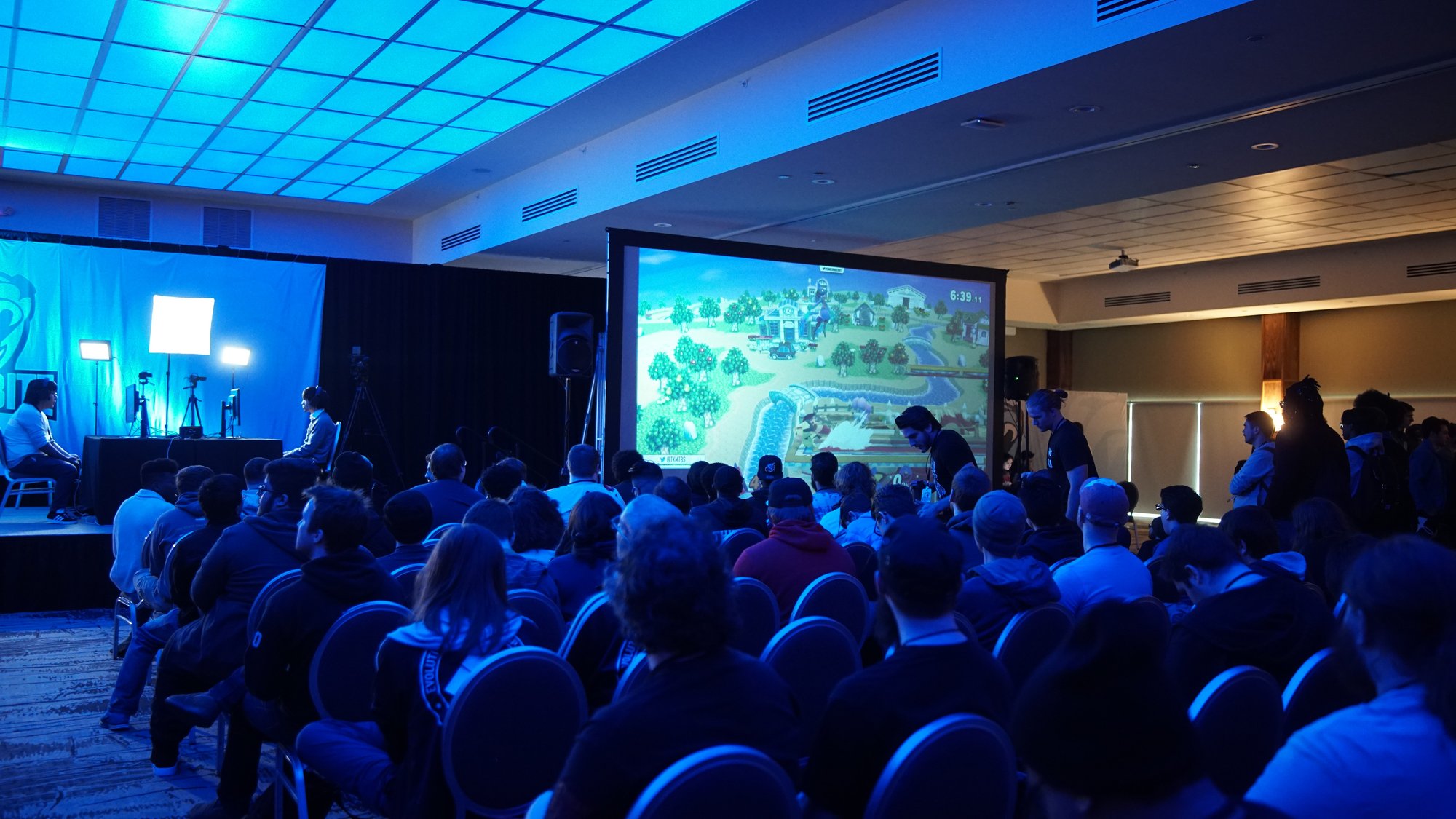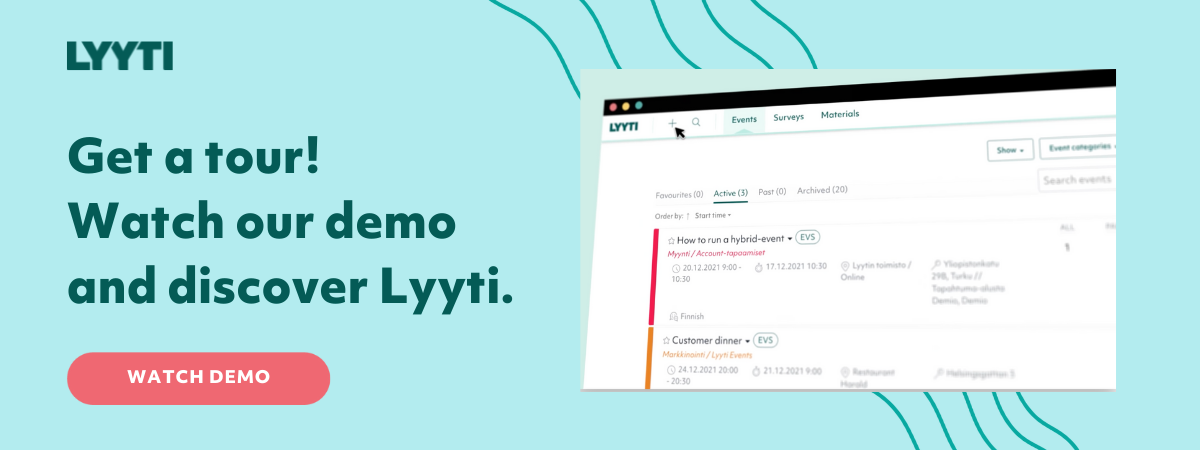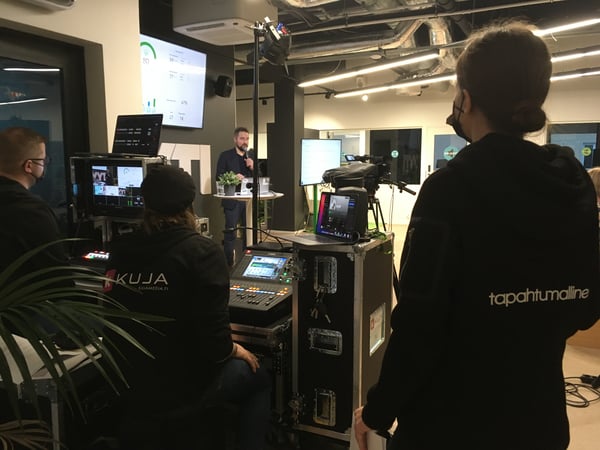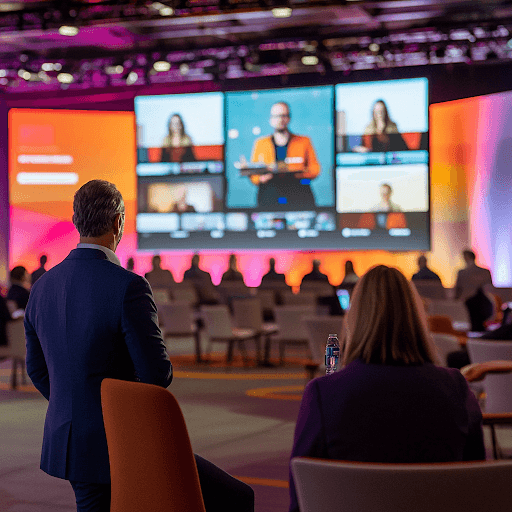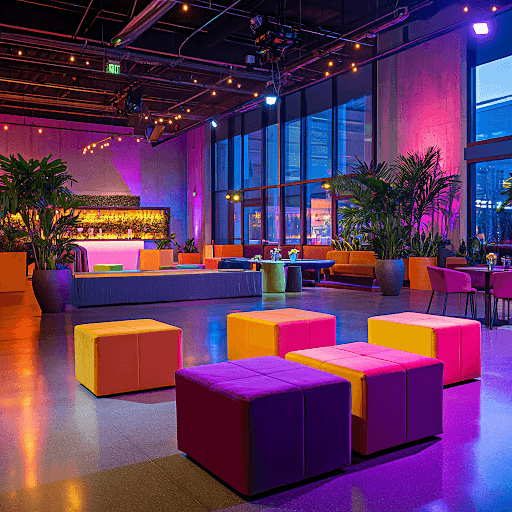There is a lot of buzz around hybrid events. Many people think that it will be the new normal of events, even when the pandemic blows over. On paper, it sounds super simple: the same event for online and onsite participants with the same content. However, there are many more variables in hybrid than just organising an online or onsite event, which we are about to dive deeper into in this blog.
All of these boil down to participant experience, which we have touched on before in this blog in our post Event Success Management – A new era in event management. The most valuable thing we have is time, and therefore every event you participate in should feel like it was worth your time. This helps the organiser stand out as the competition from people's time and attention grows. By making better events, you are doing better business. This is the real challenge in hybrid events since two entirely different audiences participate.
What differentiates a hybrid event
Even though we speak about a hybrid event, it’s not something for everyone. You should still pay close attention to your target audience. It’s the environment that changes, not the goal of your event or the profile of your ideal participant. Still, you are not organizing just one event. You are managing two. The content and keynotes might be the same, the other aspects of the two events are quite different.
It is easier to feel a connection to your onsite audience since you can see and hear them at the event. Something that you cannot do as easily online. This means that you have to find other ways to connect with your online audience, so they feel as much part of the event as the onsite participants.
Your online audience doesn't get the same sense experience as your live audience. If you are hosting a live event, there is usually something to drink and eat during the event. The smell and taste are there, which leads to more lasting memories of the event. Also, the venue might be inspiring, and there could be a lot of buzz around the room, creating more ambiance. When you are joining online, you might not have freshly brewed coffee with you, or there might be something else going on in your background (office or home) that can cause you to drift away from the event.
Encountering other participants is also different at a hybrid event. Events are a lot about the content, but networking also plays an important role. When you are meeting live, you can see who's attending, exchange thoughts with them, and trade contact information with each other on the spot. When meeting online, you as the organiser should facilitate the encounters more candidly as sometimes the online participants might not even know who else is online.
To make your event a success, we wanted to share our best tips on creating a hybrid event experience that your participants feel is worth their time.
5 tips for the best hybrid event experience
Tip no 1: Acknowledge your participants - live or online
When doing your thing during the event, be it your keynote speech or some exercises to get the blood flowing in the middle of the event, you have to keep in mind that you are talking to two different audiences. Don't forget to hold eye contact with the camera, too. It is generally much more natural to look at the people in front of you, but take some time to acknowledge the people online too.
The same thing goes when asking questions during the event. Make sure that both types of participants have a way to ask questions and that you can check and answer them too. You can ask the live audience to raise their hand and the online participant to use your platform's chat and polling possibilities when engaging people.
It is wise to have someone look over the chat and answer questions during the event. Think of it as an online host that acts the same way as a host at the venue but just focuses on the online part of the event. This person could also be the one people can contact in case of problems, such as logging in to the platform.
When asking questions from the audience, for example, "how many of you have previously participated in a hybrid event" make sure that both online and live answers will be calculated if you want to show some kind of statistic. A more sophisticated solution could be a link to poll questions that are open to both participant types, and that way, all the answers would go to the same place.
Tip no 2: Offer a unique experience
Creating the atmosphere in live circumstances is a lot easier than online. As mentioned before, the smell of coffee or the taste of fresh fruits can be a little tricky to mimic online. However, there are several ways to give something extra to your online audience. You can plan something exclusively for your online audience. You can have a small pre-event session to talk to online participants and encourage them to connect on LinkedIn or discuss other matters, such as expectations for the event and go through the features of your online tool.
Another thing you can consider is sending your online participants a voucher that they can use and order breakfast or coffee at their home or be used later. Even though it is not exactly the same as joining an on-site breakfast, it shows that you have not forgotten the online participants and want to offer them a similar experience.
Breaks and downtime in events are a bit tricky for the online participants. Since they most likely are attending from home or their office, they might not need as long a break as your on-site people. This is simply because in live encounters, people are more likely to discuss and network face to face while having coffee, so a 30 min break isn’t that long. However, it is an awfully long time to sit at your desk and stare at the “event will soon continue” text.
This can be avoided by hosting a discussion with your online audience while the other participants enjoy a break. It can be a moderated discussion about the topics or thoughts the event has invoked, or it can be just a typical networking slot. Just make sure that it is light enough that people have enough energy to focus on the second half of your event. This way, you can also create a bit of exclusivity for both parties since they both get something that the others might not.
Tip no 3: Invest in quality equipments for an uninterrupted event
When dealing with events, especially hybrid events, ensure that your technology supports your plan. Good quality microphones and cameras are a must if you want to deliver your message as efficiently as possible. Nothing breaks the immersion as plainly as a blurry picture or a distorted sound. If you don’t have these at your disposal, it is wise to have an outside partner help you out! This way, you can also have multiple camera angles for online people to see, and it is not static for the whole event. Try out different stages for different parts of the event.
Another thing that was already mentioned was the chat for online participants. It might also be cool to show the chat flow for the live audience so that they can see the discussion! Possibilities are almost limitless, so use your creativity and consult event agencies that can help you out and think outside the box.
Tip no 4: Bring the participants together to build hype around your brand
We’ve established that you are, in fact, organising two events, but that doesn’t mean you can’t bring elements of one to meet the other.
We often see the hybrid model applied to sports events. There are people in the audience and viewers at home. The sports industry has years of experience when it comes to perfecting the model. Take some clues from a sports broadcast and observe how it uses the live audience to engage the online one and vice versa. Seeing the excited faces of the people cheering in the stands is a sure way to build up the virtual experience. In turn, a big online audience will make the live audience feel like they are a part of something exceptional. They were the very few ones able to experience the event in the live setting.
Your participant should always be at the heart of your event, but events are marketing for your brand too. How will your brand be visible at the event in ways that will also bring joy to the audience?
Tip no 5: Be creative
The bar for events has been set relatively high. Once you finally participate in a live event, you expect it to be something spectacular. On the other hand, we've all attended countless webinars and generally stare at the screen all day, so online events do need to stand out to keep an audience entertained.
Fortunately, only your imagination is the limit for events and marketing. Try out different things, evaluate the feedback and evolve your events as you go along! You can do many other things that don't require additional tech but still offer something new for your audience. Try out having more engagement points in your content and drive the discussion forward, have a break for stretching during the event, or have a surprise guest hop on stage out of the blue.
You can also use tech to further enhance your event if you want. Use an interactive program that will change depending on your discussions during your event. Have breakout rooms that connect your online and on-site audience or gamify your event with quizzes or other games. Be brave and build the event to your brand's image!
Read next our case study from a hybrid event we organised recently.



